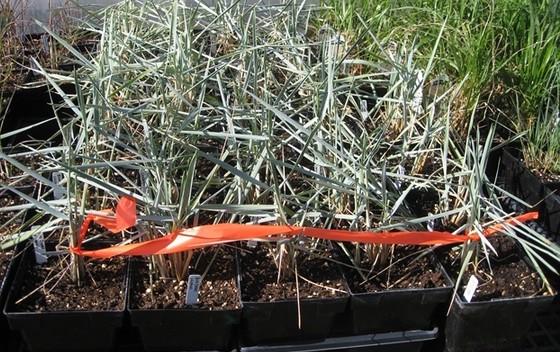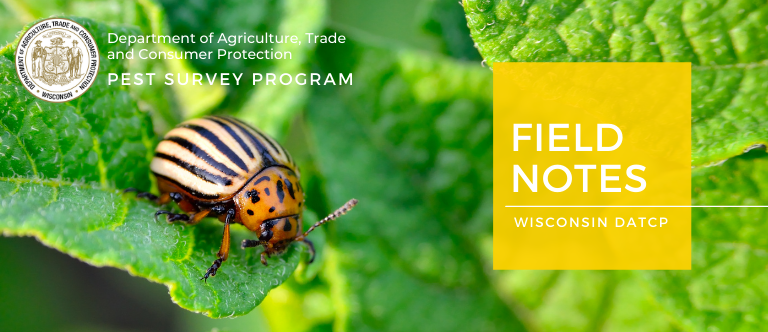 Aerial application of Btk to reduce spongy moth populations | DATCP image
Starting late next week or early the following, DATCP will begin treatments in south western Wisconsin counties for the damaging forest pest spongy moth, formerly known as gypsy moth. The aerial treatments DATCP will be conducting are the most efficient and effective method to delay the impacts associated with spongy moth outbreaks, including the cost of removing dead trees, potential loss of property value and irritation to the eyes, skin and respiratory system in some humans caused by the shed skins of the caterpillars. Residents can expect to see and hear loud, low-flying planes as early as sunrise in the following 17 counties: Barron, Bayfield, Buffalo, Burnett, Chippewa, Crawford, Dunn, Eau Claire, Grant, La Crosse, Lafayette, Pepin, Rusk, Sawyer, Trempealeau, Vernon, and Washburn.
Spraying occurs shortly after caterpillars hatch and depends on favorable weather. The planes spray Bacillus thuringiensis var. kurstaki (Btk), which is a naturally-occurring soil bacteria that kills spongy moth caterpillars feeding on canopy foliage. Btk is not toxic to people, bees, pets, or other animals and is also used in certified organic food production. Treatments will begin in southern Wisconsin and end in northern Wisconsin in mid-July. Maps of treatment areas are available at https://smaerialspray.wi.gov.
To receive up-to-date information on treatment plans:
_____________________________________
 'Blue Dune' Lyme grass is a restricted NR40 plant that cannot be sold | DATCP K. Jerabek
NR40 is another name for the WI-DNR “Invasive Species Rule” prohibiting the possession, movement, purchase or sale of invasive plants in the state of Wisconsin. The rule is divided into two subcategories based on their presence in the state. Prohibited invasive plants are species that have not become established in state but have potential for high negative impacts. All findings of prohibited invasive species, whether being offered for sale or growing in the environment, will be followed with control efforts. Restricted invasive plants are already found in state and have known negative impacts. Restricted plants cannot be sold, and if they are already growing in the environment, control is encouraged but not required.
Two examples of NR40 plants found at Wisconsin nurseries in 2021 were European frog-bit (Hydrocharis morsus-ranae) and Wild parsnip (Pastinaca sativa). European frog-bit is a prohibited plant that grows in compact, floating masses impacting aquatic life and outdoor recreation. Wild parsnip is a restricted plant which can cause long term rashes or blisters when the sap comes in contact with skin. Due to the various repercussions caused by invasive species, efforts to slow the spread and prevent introduction are encouraged at every level.
By adhering to the NR40 rule, you are assisting in keeping your community and business safe and thriving. Being familiar with the NR40 list provides another level of service when working with the public. If you are unsure of a species, there is a reference list of known synonyms and a sub-list of invasive aquatic plants. There are exemptions for some ornamental cultivars. If you need a special exemption, you can apply for a permit to grow, move, or sell a listed invasive species; i.e. any viable part of the plant (including seeds) for a limited amount of time.
_____________________________________
 DATCP Field Notes Banner
For the 2022 growing season, DATCP's Pest Survey Program is offering a new weekly email publication called Field Notes. Inside Field Notes, readers will find the same pest monitoring data and maps once provided in the Wisconsin Pest Bulletin, along with current articles on economically important plant pests affecting Wisconsin's field crops, fruits, vegetables, nurseries, and forests. Field Notes replaces the Pest Bulletin as the source for results of our field surveys, inspections, and lab diagnostic work and is a great companion to the monthly What’s Growing On newsletter. Subscribe online.
_____________________________________
For more information about Wisconsin's Nursery and Christmas Tree Programs, visit DATCP's Nursery and Christmas Tree Program webpage.
Read past issues of What's Growing On?
|